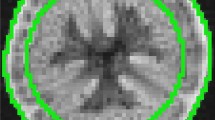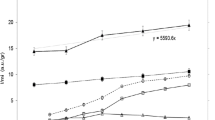Abstract
Proton nuclear magnetic resonance (NMR) techniques, such as field-cycling relaxometry, wide-line NMR spectroscopy, and magic angle spinning NMR spectroscopy, were applied to study the seeds of cress, Lepidium sativum. Field-cycling NMR relaxometry was used for the first time to investigate the properties of the whole molecular system of dry cress seeds. This method not only allowed the dynamics to be studied, but was also successful in the differentiation among the solid (i.e., carbohydrates, proteins, or fats forming a solid form of lipids) and liquid-like (oil compounds) components of the seeds. The 1H NMR relaxation dispersion of oils was interpreted as a superposition of intramolecular and intermolecular contributions. The intramolecular part was described in terms of a Lorentzian spectral density function, whereas a log–Gaussian distribution of correlation times was applied for the intermolecular dipole–dipole contribution. The models applied led to very good agreement with the experimental data and demonstrate that the contribution of the intermolecular relaxation to the overall relaxation should not be disregarded, especially at low frequencies. A power-law frequency dependence of the proton relaxation dispersion was used for the interpretation of the solid components. From the analysis of the 1H wide-line NMR spectra of the liquid-like component of hydrated cress seeds, we can conclude that the contribution of oil protons should always be taken into account when evaluating the spin–lattice relaxation times values or measuring the moisture and oil content. The application of 1H magic angle spinning NMR significantly improves resolution in the liquid-like spectrum of seeds and allows the determination of the chemical composition of cress seeds.

Proton wide-line and magic angle spining NMR spectra of dry cress seeds






Similar content being viewed by others
References
Werker E (1997) Seed anatomy. Borntraeger, Berlin
Copleland LO, McDonald MB (2001) Principles of seed Science and technology, 4th edn. Kluwer, Dordrecht
Annarao S, Sidhu OP, Roy R, Tuli R, Khetrapal CL (2008) Lipid profiling of developing Jatropha curcas L. seeds using 1H NMR spectroscopy. Bioresource Technol 99:9032–9035
Garnczarska M, Zalewski T, Kempka M (2007) Water uptake and distribution in germinating lupine seeds studied by magnetic resonance imaging and NMR spectroscopy. Physiol Plant 130:23–32
Todt H, Guthausen G, Burk W, Schmalbein D, Kamlowski A (2005) Water/moisture and FAT analysis by time-domain NMR. Food Chem 96:436–440
Sarkar BK, Yang WY, Wu Z, Tanng H, Ding S (2009) Variations of water uptake, lipid consumption, and dynamics during the germination of Sesamum indicum seed: a nuclear magnetic resonance spectroscopic investigation. Agric Food Chem 57:8213–8219
Terskikh VV, Feurtado JA, Ren C, Abrams SR, Kermode AR (2005) Water uptake and oil distribution during imbibition of seeds of western white pine monitored in vivo using magnetic resonance imaging. Planta 221:17–27
Manz B, Muller K, Kucera B, Volke F, Leubner-Metzger G (2005) Water uptake and distribution in germinating tobacco seeds investigated in vivo by nuclear magnetic resonance imaging. Plant Phys 138:1538–1551
Kikuchi K, Koizumi M, Ishida N, Kano H (2006) Water uptake by dry beans observed by micro-magnetic resonance imaging. Ann Bot 98:545
Sacchi R, Addeo F, Paolillo L (1997) 1H and 13C NMR of virgin olive oil. An overview Magn Reson Chem 35:S133–145
Garnczarska M, Zalewski T, Kempka M (2007) Changes in water status and water distribution in maturing lupin seeds studied by MR imaging and NMR spectroscopy. J Exp Bot 58:3961–3969
Ishida N, Ogawa H, Kano H (1995) Diffusion of cell-associated water in ripening barley seeds. Magn Reson Imaging 13:745–751
Krishnan P, Joshi DK, Nagarajan S, Moharir AV (2004) Characterization of germinating and non-germinating wheat seeds by nuclear magnetic resonance (NMR) spectroscopy. Eur Biophys J Biophys Lett 33:76–82
Krishnan P, Joshi DK, Nagarajan S, Moharir AV (2004) Characterization of germinating and non-viable soybean seeds by nuclear magnetic resonance (NMR) spectroscopy. Seed Sci Res 14:355–362
Morris PG, Darceuil HE, Jasinski A, Jha AK, McIntyre DJO, Northcote DH (1990) NMR microscopy of the germinating castor bean. Philos Trans Phys Sci Eng A 333:487–493
Isobe S et al (1999) Effect of electric field on physical states of cell-associated water in germinating morning glory seeds observed by 1H-NMR. Biochim Biophys Acta 17:1426
Borisjuk L, Rolletschek H, Fuchs J, Melkus G, Neuberger T (2011) Recent applications of ‘low field’ and ‘high field’ magnetic resonance in seed research. Materials 4:1426–1439
Ruta V (1989) Magic angle sample spinning NMR spectroscopy of liquids as a nondestructive method for studies of plant seeds. J Agric Food Chem 37:67–70
Borisjuk L, Rolletschek H, Neuberger T (2012) Surveying the plant’s world by magnetic resonance imaging. Plant J 70:129–146
Vozzo JA, Halloin JM, Cooper TG, Potchen EJ (1996) Use of NMR spectroscopy and magnetic resonance imaging for discriminating Juglans nigra L. Seeds Seed Sci Technol 24:457–463
Blossfeld S, Le Marie CA, Van Dusschoten D, Suessmilch S, Kuhn AJ (2011) Non-invasive investigation of root growth via NMR imaging. Commun Agric Appl Biol Sci 76:11–13
Ratcliffe RG, Roscher A, Shachar-Hill Y (2001) Plant NMR spectroscopy. Prog Nucl Magn Reson 39:267–300
Van Duynhoven J, Voda A, van Witek M, As H (2010) Time-domain NMR applied to food products. Ann Rep NMR Spectrosc 69:145–197
Belitz HD, Grosh W, Schieberle P (2009) Food chemistry, 4th edn. Springer, Berlin
Noack F (1986) NMR field-cycling spectroscopy – principles and applications. Prog NMR Spectrosc 18:171–276
Kimmich R, Anoardo E (2004) Field-cycling NMR relaxometry. Prog NMR Spectrosc 44:257–320
Anorado E, Galli G, Ferrante G (2001) Fast-field-cycling NMR: Application and instrumentation. Appl Magn Reson 20:365–404
Conte P, Bubici S, Palazzolo E, Alonozo G (2009) Solid-state 1H NMR relaxation properties of the fruit of a wild relative of eggplant at different proton Larmor frequencies. Spectrosc Lett 42:235–239
Berns AE, Bubici S, De Pasquale C, Alonzo G, Conte P (2011) Applicability of solid state fast field cycling NMR relaxometry in understanding relaxation properties of leaves and leaf- litters. Org Geochem 42:978–984
Conte P, Mineo V, Bubici S, De Pasquale C, Aboud F, Maccotta A, Planeta D, Alonzo G (2011) Dynamics of pistachio oils by proton nuclear magnetic resonance relaxation dispersion. Anal Bioanal Chem 400:1443–1450
Abragam A (1961) The principles of nuclear magnetism. Clarendon Press, Oxford
Bloembergen N, Purcell EM, Pound RV (1948) Relaxation effects in nuclear magnetic resonance absorption. Phys Rev 73:679–712
Kimmich R (1997) NMR tomography, diffusometry, relaxometry. Springer, Berlin
Kowalewski J, Maler L (2006) Nuclear spin relaxation in liquids: Theory, experiments and applications. Taylor & Francis, New York
Kimmich R (1996) Molecular motions: T 1 frequency dispersion in biological systems. In: Grant DM, Harris RK (eds) Encyclopedia of nuclear magnetic resonance. Wiley, Chichester
Noack F (1971) Nuclear magnetic resonance spectroscopy. NMR Basic Princ Prog 3:83–144
Chinachoti P, Krygsman PH (2001) Application of low-resolution NMR for simultaneous moisture and oil determination in food (oilseeds). Curr Protein Food Anal Chem A1:3.1–3.11
Canet D (1989) Construction, evolution and detection of magnetization modes designed for treating longitudinal relaxation of weakly coupled spin 1/2 systems with magnetic equivalence. Prog Nucl Magn Reson Spectroc 21:296–323
Siegel J, Benny Lee KC, Webb SED, Leveque-Fort S, Cole MJ, Fones R, Dowling K, French PMW, Lever MJ (2001) Application of the stretched exponential function to fluorescence lifetime imaging in biological tissue. Biophys J 81:1265–1274
Fleischer G, Skirda VD, Werner A (1990) NMR-investigation of restricted self-diffusion of oil in rape seeds. Eur Biophys J 19:25–30
Wollenberg K (1991) Quantitative triacyclglycerol analysis of whole vegetable seeds by 1H and 13C magic angle spinning NMR spectroscopy. JAOCS 68:391–400
Conte P, Maccota A, De Pasquale C, Alonzo G (2010) Supramolecular organization of triglycerides in extra-virgin olive oils as assesses by NMR relaxometry. Fresenius Environ Bull 19:2077–2083
Hess PS, O’Hare GA (2006) Oxidation of linseed oil: temperature effect. Ind Eng Chem 42:1424–1431
Korb JP, Bryant RG (2002) Magnetic field dependence of proton spin–lattice relaxation times. Magn Reson Med 48:21–26
Doi M, Edwards SW (1986) The theory of polymer dynamics. Clarendon Press, Oxford
Denissov A, Kroutieva M, Fatkulin N, Kimmich R (2002) Segmental diffusion and nuclear magnetic resonance spin–lattice relaxation of polymer chains confined in tubes: analytical treatment and Monte Carlo simulation of the crossover from Rouse to reputation dynamics. J Chem Phys 116:5217–5230
Fatkullin N, Kimmich R, Weber HW (1993) Spin–lattice relaxation of polymers: the memory-function formalism. Phys Rev E 47:4600–4603
Rachocki A, Tritt-Goc J, Rachocki A, Kowalczuk J, Tritt-Goc J (2006) How we can interpret the T 1 dispersion of MC, HPMC and HPC polymers above glass temperature? Solid State NMR 30:192–197
Nusser W, Kimmich R, Winter F (1988) solid state NMR study of protein/polypeptide backbone fluctuations interpreted by multiple trapping diffusion of dilating defects. J Phys Chem 92:6808–6814
Bryant RG, Mendelson DA, Lester CC (1991) The magnetic field dependence of proton spin relaxation in tissues. Magn Reson Med 21:117–126
Acknowledgments
The authors thank Joanna Starzyk from the Faculty of Mathematics, Physics and Computer Science of Maria Curie-Skłodowska University in Lublin and Magdalena Cichocka from the Faculty of Physics of Adam Mickiewicz University in Poznań for their technical assistance with NMR measurements..
Author information
Authors and Affiliations
Corresponding author
Rights and permissions
About this article
Cite this article
Rachocki, A., Latanowicz, L. & Tritt-Goc, J. Dynamic processes and chemical composition of Lepidium sativum seeds determined by means of field-cycling NMR relaxometry and NMR spectroscopy. Anal Bioanal Chem 404, 3155–3164 (2012). https://doi.org/10.1007/s00216-012-6409-5
Received:
Revised:
Accepted:
Published:
Issue Date:
DOI: https://doi.org/10.1007/s00216-012-6409-5




